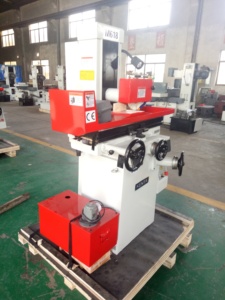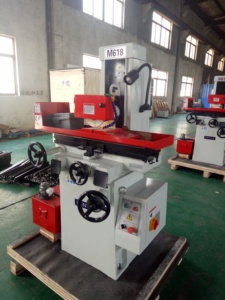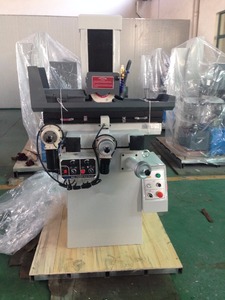Types of small surface grinders
There are generally two types of small surface grinders: manual and automatic. However, three more types can cater to many needs: portable, CNC, and wet or dry grinders.
- Manual surface grinder: A manual surface grinder machine is operated by the hand. The handwheels can help operators move the table back and forth and left and right. The machine uses small grinding wheels to grind surfaces to create a smooth shiny finish as well as edges, grooves, faces, and profiles.
- Automatic surface grinder: An automatic grinder may have features like magnetic chucks and automatic controls. It is easier to use than manual grinders. An automatic surface grinder machine can have another grinding tool chuck that uses electricity to hold workpieces. It can grind metals including steel with less human effort. An automatic surface grinder can improve productivity.
- Portable surface grinder: A portable grinder machine is smaller and lighter than most grinders. It is easy to carry or store away when not in use. Some portable grinders have handles for extra convenience and protection. Portable grinders can be powered by electricity or batteries, and they can accept grinding wheels of various sizes and types.
- CNC surface grinder: A CNC surface grinder uses a computer to control its operations. The computer can precisely set many parameters including the depth of the cut, the speed, the direction of movement, the time cycles, etc. The grinder can move in all three axes: the X-axis for side to side, the Y-axis for front to back, and the Z-axis for up and down. CNC surface grinders can provide great accuracy with minimal human effort.
- Wet and dry surface grinders: A wet surface grinder uses water to cool the grinding wheel. The cooling can reduce the heat generated during the grinding process. Water can also maintain the cleanliness of the work area by minimizing the dust produced. A wet grinder is less likely to overheat and damage the workpiece or the tool itself. A dry surface grinder does not use water or coolant during the grinding process.
Specification and maintenance
Small surface grinders have varied specifications depending on the type and model. Key surface grinder specifications will include the table size, spindle speed, spindle motor power, feeding system, power source, and wheel size.
- Table Size: The table size on small surface grinders varies with models. It is measured in length by width. For example, some grinders may have table sizes of 200x500mm, 300x600mm, or even 400x800mm. The table size affects the dimensions of workpieces that can be accommodated and processed on the machine.
- Spindle speed:Small surface grinders have varied spindle speeds. They usually range from 3000rpm to 6000rpm. The spindle speed determines the grinding wheel's operating speed, impacting the material removal rate and surface finish.
- Spindle motor power: Surface grinders have different motor powers, measured in horsepower (hp) or kilowatts (kw). The motor power influences the grinding wheel's torque and control. It, too, impacts the machine's capacity to handle various workpieces and materials.
- Feeding system: Surface grinders have various feeding systems, such as manual drive, hydraulic feed, automatic feed, or CNC control. The type of feeding system affects the precision and ease of operation when grinding surfaces.
- Wheel size: The wheels of small surface grinders come in various sizes and specifications depending on the area of use. Some have a 10-inch wheel, while others have a larger 12-inch wheel. The wheel size and specification determine the surface grinder's suitability for specific grinding tasks and applications.
- Power source: Small surface grinders are mainly electric-powered. Power sources for electric surface grinders can be AC or DC power. The power source affects the grinder's performance, control, and application ends.
It is crucial to perform regular maintenance on small surface grinders to keep them in tip-top shape and ensure they have a long lifespan. With the right care, these machines can serve businesses for many decades without breaking down.
- Clean: Grinders should be cleaned regularly to keep dirt, debris, and coolant off their surfaces and components. Keeping surfaces clean is crucial to ensuring the machine operates smoothly and efficiently. Operators can use air compressors or vacuums to remove debris. They can also use non-abrasive cleaners to remove any remaining debris.
- Lubrication: Lubricate the sliding parts of the small grinder surfaces regularly with enough lubricant. Lubrication prolongs the life of the components while promoting smooth operation. Regularly adding lubricant also helps to prevent wear due to friction and minimizes the risk of overheating. Operators should pay close attention to lubrication points as highlighted by the manufacturer's manual.
- Precision inspection: The precision of small surface grinders should be checked periodically, especially if the machine is used often on precision workpieces. When it is checked for precision, adjustments can be made to level up the tables and align the components. Regularly calibrating helps maintain the grinding machine's accuracy while improving the quality of surfaces finished.
- Replacement of parts and wheels: Parts of surface grinders get worn out after a while, especially if they are used often. These include the grinding wheels and belts, among others. The grinding wheels usually get worn out due to the constant shaving of workpieces. What’s more, subscribers to this list can improve work surface finish by routinely replacing their grinding wheels.
Scenarios of small surface grinders
Due to their versatility and utility, small surface grinders are used in various industries. Here are some common applications and uses of small surface grinders.
- Cutting and shaping metals: One of the main applications of small surface grinders is for cutting and shaping different surfaces of metals. They are used to cut and shape materials, including stainless steel, carbon steel, and copper. Small surface grinders produce a smooth surface for imprecise and accurate metalworking. They are usually used in industries such as aerospace automotive and machinery manufacturing.
- Industry maintenance and repair: Surface grinders are essential tools for maintenance and repair work in different equipment, machines, and tools. The surface grinders can quickly level the uneven surfaces of work tools and machinery. They can also remove the worn-out or damaged parts of the workpieces. In addition to this, small surface grinders can effectively restore the cutting edges of tools such as drill bits and milling cutters. Surface grinders assist technicians and machinists in repair work. They ensure a precise and smooth surface finish for optimal working and functioning.
- Smaller and complex parts: Desktop and benchtop surface grinders are perfect for grinding small, complex workpieces. They are usually used in industries such as electronics and precision machinery. With their small size and high precision, surface grinders can easily cope with the challenges posed by intricate and small workpieces. They deliver quality results and workpieces with excellent surface finishes.
- Tool and die making: Tool and die making is a challenging task that requires the use of complex and precision workpieces. Small surface grinders assist in shaping and grinding tools and dies to precise specifications. With surface grinders, operators can enjoy the excellent surface finishes and accurate dimensions required of tools and dies. These devices are essential for molding cavities, cutting tools, jigs, and fixtures, which are usually made from hard metals like steel.
- Woodworking industry: In the woodworking industry, small surface grinders can be used to grind down wood with metal embedded within. This may include nails or screws. Small surface grinders can also be used for furniture restoration. They can help remove the rusted metal parts and get down to the smooth surface ready for refinishing and repainting. Though grinders are not usually considered an essential tool for woodworking, they can save a lot of time and effort when dealing with metal and wooden workpieces.
How to Choose Small Surface Grinders
Here are some important factors to consider when choosing small surface grinders.
-
Feeding System
Consider the kind of feeding system used by the surface grinder and its mechanism. Many small surface grinders have automatic feeding systems that boost work efficiency by reducing the need for manual intervention. They also provide varied feed rates to accommodate different workpieces and processes. Some models have a reciprocating feed motion. It helps to grind longer workpieces faster and shows better surface finishes.
-
Wheel Size and RPM
The grinding wheel's dimensions impact the grinder's capability and performance. Most mini surface grinders take 200-300 mm wheels. A surface grinder with a larger wheel will grind more surfaces in less time. Smaller wheels are more affordable and easier to replace. Consider the rotations per minute (RPM) of the grinding wheel. A higher wheel speed enables efficient grinding. However, it also magnifies the surface grinder's noise and vibration.
-
Safety Features
Focus on the safety elements of the surface grinder. These safety features protect operators from possible hazards when using the grinding machine. Does the surface grinder have a protection guard on the grinding wheel? The guard helps to limit operators' exposure to the rotating grinding wheel. Check for overload and overheat protection. An overload or cooling system protects the grinder against damage from excessive current or heat.
Q & A
Q1: What are the recent trends in surface grinder machines?
A1: The trend is toward automation, safety, and precision in surface grinder machines. Small surface grinders may have some automation features, like automatic feeding and tool changing, which can make the grinding process more efficient. Developments in artificial intelligence (AI) and surface grinder technology may lead to intelligent surface grinders with automated quality control. Sensor systems could detect surface quality and automatically adjust grinding parameters for optimal results.
Q2: What is the difference between a small and large surface grinder?
A2: The main difference between small and large surface grinders is the dimensions and the grinding capacity. Large surface grinders are used for large parts. They also require a large amount of power and high RPM to grind large parts surfaces. A large machine weighs several tons and has heavy cast iron frames. Large-dimension parts are used in various industries, including aerospace, power generation, oil and gas, marine, and metal fabrication.
Q3: Can buyers get customized small surface grinders?
A3: Manufacturers may offer customization options. These might include modifications to the design, addition of specific features, changes in color or branding, or adjustments to the machine's specifications to meet particular requirements.

















































































































































































































